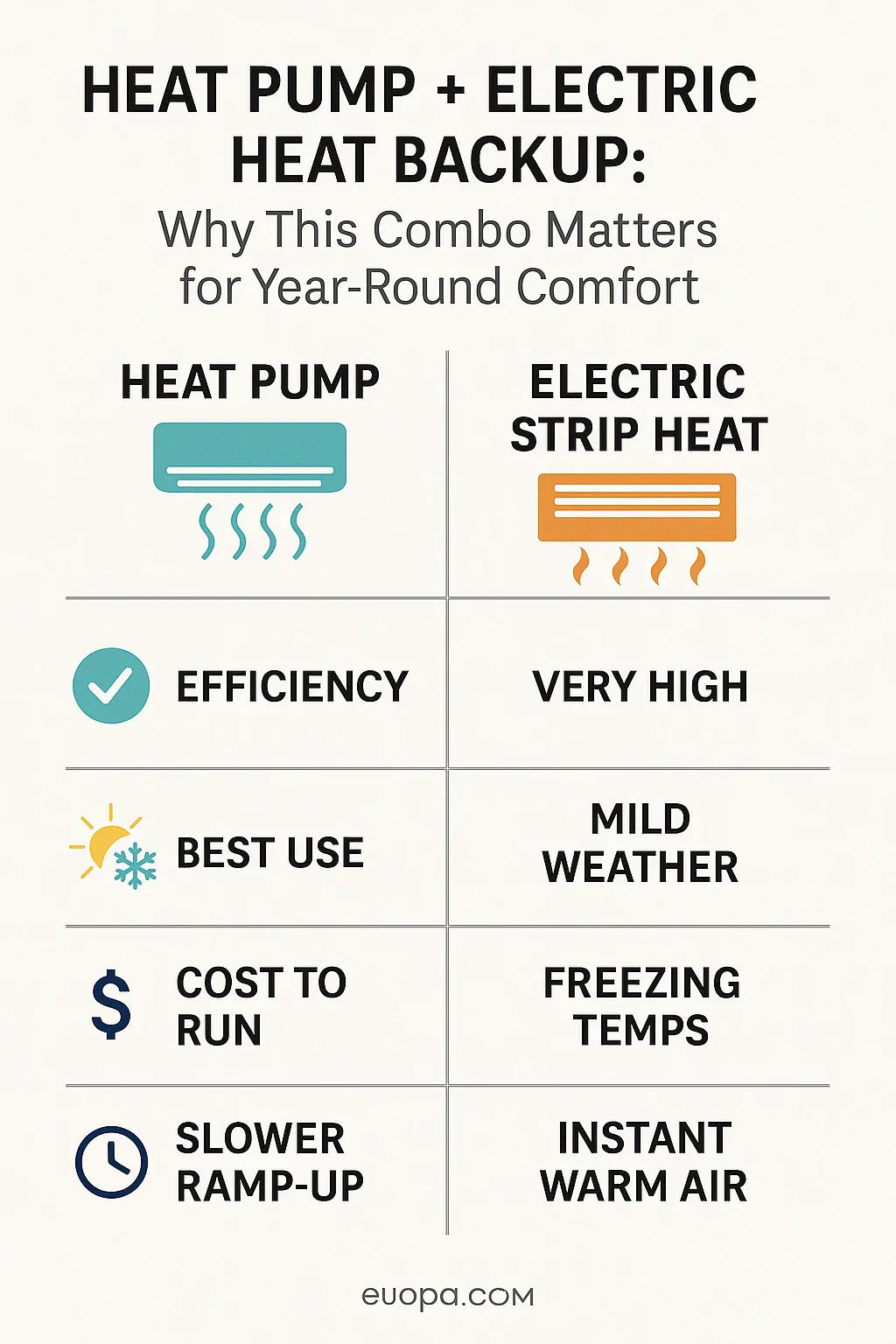When you’re choosing a PTAC unit like the Amana Distinctions 9,000 BTU PTAC Heat Pump with 2.5 kW Electric Heat Backup, one phrase jumps out: “heat pump with electric backup.”
But what does that mean—and why should you care?
I’m Samantha, and I’ve helped family and friends set up PTACs in guest rooms, studios, and small rentals. Through trial and error, I’ve learned that the dual system design is not just a feature—it’s the reason these units shine for year-round comfort.
Let’s dive into why this combination matters, how it works, and whether it’s the right choice for your space.
🌬️ What Is a Heat Pump (and Why It’s So Efficient)?
At its core, a heat pump is like a two-way air conditioner.
-
Cooling mode: Pulls heat out of your room and dumps it outside.
-
Heating mode: Runs in reverse, pulling heat from the outdoor air and moving it inside.
Unlike electric resistance heating, which creates heat by burning energy, a heat pump simply moves heat. That’s why it’s so efficient.
📊 According to the U.S. Department of Energy, heat pumps can deliver up to 3 times more heating energy than the electricity they consume.
👉 Translation: You get more comfort per dollar in most seasons.
❄️ Where Heat Pumps Struggle: Cold Weather Limits
Heat pumps are amazing, but they aren’t perfect.
-
When the outdoor temperature drops below 35–40°F, the system struggles to pull enough heat from the air.
-
In freezing climates, the output drops while the demand for heat rises.
That’s why in northern winters, a heat pump alone might leave you chilly.
🔥 Enter Electric Heat Backup
This is where the electric strip heater (in the Amana model, it’s 2.5 kW) comes in.
-
Think of it as a built-in space heater.
-
It switches on automatically when the heat pump can’t keep up.
-
Delivers reliable, steady heat no matter how cold it gets outside.
Yes, electric resistance heating costs more to run—but it’s only used when necessary, which balances efficiency with peace of mind.
⚖️ Heat Pump vs. Electric Backup: A Side-by-Side Look
| Feature | Heat Pump | Electric Backup |
|---|---|---|
| Efficiency | ✅ 2–3x more efficient than electric | ❌ Low efficiency |
| Best Use | Mild & moderate temps | Freezing weather |
| Energy Cost | Lower bills | Higher bills |
| Comfort Level | Consistent but slower warm-up | Instant warm air |
| Reliability | Limited in extreme cold | Works in any temp |
💡 The combo gives you the best of both worlds: efficient comfort most of the time, with a dependable safety net for winter extremes.
🏠 When This Combo Shines
🛏️ Guest Rooms
-
Guests expect comfort—no excuses.
-
Even if your main HVAC doesn’t reach well, the PTAC delivers cool summers and warm winters.
🏢 Studios & Small Apartments
-
Daily use demands efficiency.
-
The heat pump keeps bills low, while the backup ensures cold snaps don’t turn into shivering nights.
💼 Small Offices
-
Electronics and multiple people add heat load.
-
Backup heating helps early mornings or winter storms when the office feels chilly.
📖 Samantha’s Real-World Story
“In my cousin’s 340 sq. ft. Airbnb studio in North Carolina, we installed the 9,000 BTU Amana PTAC. Most of the year, the heat pump handled everything efficiently. But one January, temps dipped below freezing. The electric backup kicked in automatically, and guests never even noticed—it stayed cozy without portable heaters.”
That’s the magic: guaranteed comfort with built-in insurance.
💰 Cost & Energy Impact
Some homeowners worry: “Won’t the backup cost a fortune to run?”
Here’s the truth:
-
Heat pump handles 80–90% of the heating season.
-
Backup only kicks in during the coldest 10–20% of hours.
-
Over the course of a year, your bills are still much lower than electric-only heating.
According to the Energy Star program, modern heat pumps with backup systems can cut heating costs by up to 50% compared to electric resistance heating alone.
🛠️ Maintenance Tips for Both Systems
To keep both modes working properly:
🌀 For the Heat Pump
-
Clean or replace filters every 30–60 days.
-
Keep outdoor coils clear of dirt and debris.
-
Check refrigerant levels during annual service.
🔥 For the Electric Backup
-
Test the strip heat before winter starts.
-
Ensure wiring and controls are in good shape.
-
Don’t block airflow—backup needs the same clear vents.
🔗 See ASHRAE’s HVAC maintenance standards for professional guidance.
🌡️ Climate Zone Guide
Is this combo right for you?
-
Mild Climates (South, Mid-Atlantic, West Coast): Heat pump does most of the work. Backup hardly runs.
-
Moderate Climates (Midwest, Mid-South): Heat pump runs most days; backup kicks in occasionally.
-
Cold Climates (Northeast, Upper Midwest): Heat pump saves energy in fall/spring; backup ensures survival in winter.
Check your zone on the DOE Climate Map.
🧮 Example: Cost Comparison
Let’s say you live in a 400 sq. ft. studio in Chicago:
-
Without heat pump (electric only): $90–120/month in winter.
-
With heat pump + backup: $50–70/month most of winter, $90 only on extreme cold weeks.
Savings: ~30–40% annually, plus year-round cooling built in.
🔗 Try the Energy Star savings calculator to see your numbers.
✅ Key Takeaways
-
Heat pumps are efficient in most weather but need help in freezing temps.
-
Electric backup fills the gap, ensuring comfort no matter the climate.
-
The Amana 9,000 BTU PTAC with 2.5 kW backup is perfect for guest rooms, studios, and small spaces where reliability matters.
-
You’ll save on energy bills most of the year and have peace of mind for those rare cold snaps.
In the next topic we will know more about: How Efficient Is the Amana 9,000 BTU Unit? Understanding EER, CEER & Heat Pump Ratings







